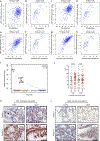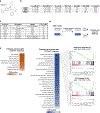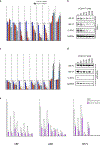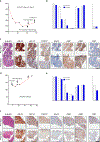Targeting the p300/CBP Axis in Lethal Prostate Cancer
- PMID: 33431496
- PMCID: PMC8102310
- DOI: 10.1158/2159-8290.CD-20-0751
Targeting the p300/CBP Axis in Lethal Prostate Cancer
Abstract
Resistance to androgen receptor (AR) blockade in castration-resistant prostate cancer (CRPC) is associated with sustained AR signaling, including through alternative splicing of AR (AR-SV). Inhibitors of transcriptional coactivators that regulate AR activity, including the paralog histone acetyltransferase proteins p300 and CBP, are attractive therapeutic targets for lethal prostate cancer. Herein, we validate targeting p300/CBP as a therapeutic strategy for lethal prostate cancer and describe CCS1477, a novel small-molecule inhibitor of the p300/CBP conserved bromodomain. We show that CCS1477 inhibits cell proliferation in prostate cancer cell lines and decreases AR- and C-MYC-regulated gene expression. In AR-SV-driven models, CCS1477 has antitumor activity, regulating AR and C-MYC signaling. Early clinical studies suggest that CCS1477 modulates KLK3 blood levels and regulates CRPC biopsy biomarker expression. Overall, CCS1477 shows promise for the treatment of patients with advanced prostate cancer. SIGNIFICANCE: Treating CRPC remains challenging due to persistent AR signaling. Inhibiting transcriptional AR coactivators is an attractive therapeutic strategy. CCS1477, an inhibitor of p300/CBP, inhibits growth and AR activity in CRPC models, and can affect metastatic CRPC target expression in serial clinical biopsies.See related commentary by Rasool et al., p. 1011.This article is highlighted in the In This Issue feature, p. 995.
©2021 American Association for Cancer Research.
Figures







Comment in
-
Toppling the HAT to Treat Lethal Prostate Cancer.Cancer Discov. 2021 May;11(5):1011-1013. doi: 10.1158/2159-8290.CD-21-0184. Cancer Discov. 2021. PMID: 33947717
References
-
- Culp MB, Soerjomataram I, Efstathiou JA, Bray F, Jemal A. Recent Global Patterns in Prostate Cancer Incidence and Mortality Rates. European urology. 2020;77(1):38–52. - PubMed
-
- Visakorpi T, Hyytinen E, Koivisto P, Tanner M, Keinanen R, Palmberg C, et al. In vivo amplification of the androgen receptor gene and progression of human prostate cancer. Nature genetics. 1995;9(4):401–6. - PubMed
-
- Chen CD, Welsbie DS, Tran C, Baek SH, Chen R, Vessella R, et al. Molecular determinants of resistance to antiandrogen therapy. Nat Med 2004;10(1):33–9. - PubMed
Publication types
MeSH terms
Substances
Grants and funding
LinkOut - more resources
Full Text Sources
Other Literature Sources
Molecular Biology Databases
Research Materials
Miscellaneous

